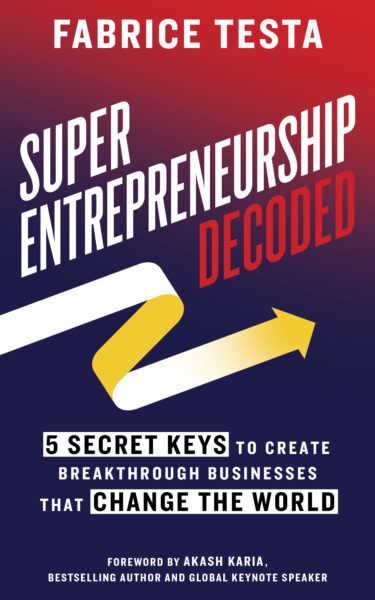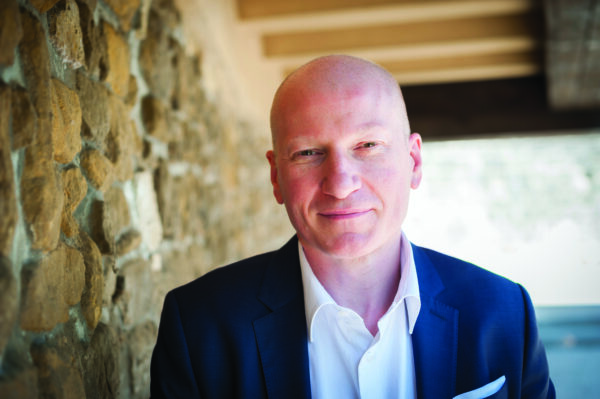Across the globe, entrepreneurs and innovators are working hard to tackle some of humanity’s biggest challenges. Fabrice Testa wrote Super-Entrepreneurship Decoded for inventors, pioneers, and change-makers who aspire to improve the world with bold ideas that yield remarkable results. It provides a step-by-step guide to turning those dreams into reality. Fabrice also shares the five secrets of the leading super-achievers who are transforming how we travel, eat, work, and navigate our everyday lives.
I recently caught up with Fabrice to learn more about what inspired him to write the book, his favorite idea he shares with readers, and how that idea has impacted his business.

What happened that made you decide to write the book? What was the exact moment when you realized these ideas needed to get out there?
After having founded or co-founded several companies, and having coached and mentored over 100 founders of innovative companies, I realized that while many of them have big ideas, they have difficulties getting started because they are stuck and paralyzed by the fear of failure. Some start to materialize their dream, but they are not able to attract the required resources like co-founders, funding, or partners. Or they launch their company at the wrong time, or they don’t know how to recruit people, or what they should do to maximize their chances of success.
During the COVID-19 crisis, and especially during the lockdown, I realized that we need more of those entrepreneurs and innovators to solve urgent big problems, but that they need a guide to help them. Super-Entrepreneurship Decoded aims to be that guide. It’s of course not a guaranteed recipe for success, but by following the proposed methodology, change-makers and trailblazers can minimize the mistakes, and eventually build a breakthrough venture.
What’s your favorite specific, actionable idea in the book?
The super-achievers I described in my book (super-entrepreneurs, super-athletes, super-artists) go from dreaming to planning to building. Initially, it’s important to dream, to have a vision of how to impact the world, how to build a better future by solving a huge problem, or how to achieve your wildest goals. But dreaming is not enough. As I always say, an idea remains an idea until it’s materialized! So, after dreaming, it’s important to elaborate a plan: where exactly to go, with whom, how; what are the possible options, which ones make more sense.
In the book, I recommend having a master plan. One should start by having big goals and then define near-term achievable goals. What should I do in the next three months or the next six months to get closer to my big goals? Finally, once the plan is ready, one should just do it. I see many people elaborating a lot of plans, but they never do it.
Super-achievers described in my book move ahead and take their chance. Finally, what makes them unique is that they are maniacal about perfecting their craft and achieving excellence in whatever they do. They are not complacent and they look at those 5% that are really going to harm them. Perfect execution is a key differentiator of super-achievers.

What’s a story of how you’ve applied this idea in your own life? What has this idea done for you?
In 2005, I joined a small team of pioneers who wanted to digitalize the whole cinema industry. You must understand that in the early 2000s, cinema was the only media not digital yet. The music and TV industries had already transitioned to digital, but not cinema.
By that time, 35mm analog prints were massively used, leading to a huge usage of chemicals, toxic materials, and a big carbon footprint. A successful Belgian entrepreneur decided to launch a new company that would digitalize cinemas providing digital projection equipment and digitalizing the movies to replace the 35mm physical reels. He was highly motivated by this to reduce carbon emissions and pollution generated by analog film prints.
When the company XDC was launched in 2005, we were completely unknown in the cinema world. By that time, the big names were Technicolor, Deluxe, or Kodak. My mission by joining the company was to create a strong name around XDC, reinforce the branding, and get recognized in that very conservative industry as a key player. Every day, we were facing people saying that we will never succeed, that moviegoers preferred analog projection, that cinema theaters will never transition to digital projection, that movie studios will never digitalize their films. I can’t tell you how many naysayers we got! I can’t remember how many setbacks we faced: cinema servers that did not work, digitalized movies with problems, and so on.
The first two years were really tough. Several team members left the company because they didn’t believe we will ever succeed. In 2007, we managed to become the official partner of the Cannes Film Festival for all their digital projections. This was a real breakthrough. The largest film festival showing several movies in digital format, and the name of XDC everywhere. Immediately we got recognized among the big players of the cinema industry. Finally, people understood we were a solid company and we were going to be a game-changer.
In 2008, we switched our business model, and we started to sign agreements with the US major studios, Warner, Fox, Disney, Sony, and Universal. Immediately after, the movie Avatar from James Cameron was released and mostly in 3D format. The only way to show 3D projections was to equip cinemas with digital projection systems. That event was for us a pivotal moment enabling the real take-off of the company. Our crazy idea was finally leading to something big: the massive digitalization of thousands of cinemas, the massive digitalization of hundreds of movies, which meant the elimination of thousands of analog toxic 35mm print reels, replaced by copies on hard disks, or sent via fiber or satellite.
After the dreaming phase, it was now time to plan and build. We refined our master plan, we designed a viable business model, we raised the necessary funding and we hired the required people, preparing the company for the next big step. We trusted our crazy idea, and we were able to materialize it, but now we had to scale the business and create some real breakthrough business. This was achieved by forming a group of 200 people with subsidiaries and affiliated companies all over Europe, with offices from London to Moscow. Finally, we achieved €100m turnover. This was our big target. After 10 years, the company was sold to its main competitor to create one of the largest companies in the world servicing the cinema industry.
Super-achievers like super-entrepreneurs trust their crazy ideas and pay great attention to planning and building. This is exactly what the five secrets I’m unveiling in Super-Entrepreneurship Decoded are explaining in a very concise and actionable method. By applying the five secrets, it may lead to change completely the face of industry as we did with cinema. So next time you go with your family or your friends to the cinema theater, enjoy the digital format, and think that this started initially from a crazy idea!